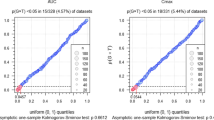Abstract
Purpose. To assess the degree to which the maximum unboundconcentration of inhibitor at the inlet to the liver (Iinlet,u,max), used in theprediction of drug-drug interactions, overestimates the unboundconcentration in the liver.
Methods. The estimated value of Iinlet,u,max was compared with theunbound concentrations in systemic blood, liver, and inlet to the liver,obtained in a simulation study based on a physiological flow model.As an example, a tolbutamide/sulfaphenazole interaction was predictedtaking the plasma concentration profile of the inhibitor intoconsideration.
Results. The value of Iinlet,u,max differed from the concentration in eachcompartment, depending on the intrinsic metabolic clearance in theliver, first-order absorption rate constant, non-hepatia clearance andliver-to-blood concentration ratio (Kp) of the inhibitor. The AUC oftolbutamide was predicted to increase 4-fold when co-administeredwith sulfaphenazole, which agreed well with in vivo observations andwas comparable with the predictions based on a fixed value of Iinlet,u,max.The blood concentration of tolbutamide was predicted to increase whenit was co-administered with as little as 1/100 of the clinical doseof sulfaphenazole.
Conclusions. Although Iinlet,u,max overestimated the unboundconcentration in the liver, the tolbutamide/sulfaphenazole interaction couldbe successfully predicted by using a fixed value of Iinlet,u,max, indicatingthat the unbound concentration of sulfaphenazole in the liver after itsclinical dose is by far larger than the concentration to inhibitCYP2C9-mediated metabolism and that care should be taken when it isco-administered with drugs that are substrates of CYP2C9.
Similar content being viewed by others
REFERENCES
K. Ito, T. Iwatsubo, S. Kanamitsu, Y. Nakajima, and Y. Sugiyama. Quantitative prediction of in vivo drug clearance and drug interactions from in vitro data on metabolism, together with binding and transport. Annu. Rev. Pharmacol. Toxicol. 38:461-499 (1998).
K. Ito, T. Iwatsubo, S. Kanamitsu, K. Ueda, H. Suzuki, and Y. Sugiyama. Prediction of pharmacokinetic alterations caused by drug-drug interactions: metabolic interaction in the liver. Pharmacol. Rev. 50:387-411 (1998).
M. E. Veronese, J. O. Miners, D. Randles, D. Gregov, and D. J. Birkett. Validation of the tolbutamide metabolic ratio for population screening with use of sulfaphenazole to produce model phenotypic poor metabolizers. Clin. Pharmacol. Ther. 47:403-411 (1990).
O. Sugita, Y. Sawada, Y. Sugiyama, T. Iga, and M. Hanano. Prediction of drug-drug interaction from in vitro plasma protein binding and metabolism: a study of tolbutamide-sulfonamide interaction in rats. Biochem. Pharmacol. 30: 3347-3354 (1981).
D. J. Back and M. L'E. Orme. Genetic factors influencing the metabolism of tolbutamide. Pharmacol. Ther. 44:147-155 (1989).
E. Nelson and I. O'Reilly. Kinetics of carboxytolbutamide excretion following tolbutamide and carboxytolbutamide administration. J. Pharmacol. Exp. Ther. 132:103-109 (1961).
O. Sugita, Y. Sawada, Y. Sugiyama, T. Iga, and M. Hanano. Effect of sulfaphenazole on tolbutamide distribution in rabbits: analysis of interspecies differences in tissue distribution of tolbutamide. J. Pharm. Sci. 73:631-634 (1984).
O. Sugita, Y. Sawada, Y. Sugiyama, T. Iga, and M. Hanano. Kinetic analysis of tolbutamide-sulfonamide interaction in rabbits based on clearance concept. Drug Metab. Dispos. 12:131-138 (1984).
K. B. Bischoff, R. L. Dedrick, D. S. Zaharko, and J. A. Longstretth. Methotrexate pharmacokinetics. J. Pharm. Sci. 60:1128-1133 (1971).
R. L. Dedrick. Animal scale-up. J. Pharmacokinet. Biopharm. 1:435-461 (1973).
B. Montandon, R. J. Roberts, and L. J. Fischer. Computer simulation of sulfobromophthalein kinetics in the rat using flow-limited models with extrapolation to man. J. Pharmacokin. Biopharm. 3:277-290 (1975).
J. O. Miners, K. J. Smith, R. A. Robson, M. E. McManus, M. E. Veronese, and D. J. Birkett. Tolbutamide hydroxylation by human liver microsomes. Biochem. Pharmacol. 37:1137-1144 (1988).
G. F. Peart, J. Boutagy, and G. M. Shenfield. Lack of relationship between tolbutamide and debrisoquine oxidation phenotype. Eur. J. Clin. Pharmacol. 33:397-402 (1987).
K. Tanioku and M. Nakahira. Long-acting sulfadrugs (in Japanese). Hifuka-no-Rinsho 2:717-724 (1960).
T. B. Vree, E. W. J. B. Kolmer, and Y. A. Hekster. High pressure liquid chromatographic analysis and preliminary pharmacokinetics of sulfaphenazole and its N2-glucuronide and N4-acetyl metabolites in plasma and urine of man. Pharm. Weekblad Sci. Edition 12:243-246 (1990).
R. J. Bertz and G. R. Granneman. Use of in vitro and in vivo data to estimate the likelihood of metabolic pharmacokinetic interactions. Clin. Pharmacokin. 32:210-258 (1997).
L. L. von Moltke, D. J. Greenblatt, J. Schmider, C. E. Wright, J. S. Harmatz, and R. I. Shader. In vivo approaches to predicting drug interactions in vivo. Biochem. Pharmacol. 55:113-122 (1998).
L. K. Christensen, J. M. Hansen, and M. Kristensen. Sulfaphenazole-induced hypoglycaemic attacks in tolbutamide-treated diabetics. Lancet 2:1298-1301 (1963).
R. C. Thomas and G. J. Ikeda. The metabolic fate of tolbutamide in man and in the rat. J. Med. Chem. 9:507-510 (1966).
Author information
Authors and Affiliations
Rights and permissions
About this article
Cite this article
Kanamitsu, Si., Ito, K. & Sugiyama, Y. Quantitative Prediction of In Vivo Drug-Drug Interactions from In Vitro Data Based on Physiological Pharmacokinetics: Use of Maximum Unbound Concentration of Inhibitor at the Inlet to the Liver. Pharm Res 17, 336–343 (2000). https://doi.org/10.1023/A:1007509324428
Issue Date:
DOI: https://doi.org/10.1023/A:1007509324428




